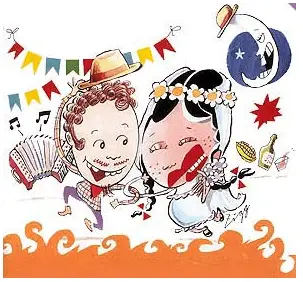Text interpretation, “Olha o arraiá”, aimed at 9th grade students. The proposed questions contemplate the theme and the linguistic resources used in the construction of this interesting text about the typical June festivals.
This Portuguese activity is available for download in an editable Word template, ready to print in PDF and also the completed activity.
Download this interpretation at:
SCHOOL: DATE:
PROF: CLASS:
NAME:
Read:
Discover the celebrations behind the June festivities of yesterday and today
by Fernanda Turino
Look at the rain! It's a lie! Look at the snake! It's a lie! Look at the hominy! Hey, it's true! This time of year is a delight, isn't it? A lot of June parties happening with a lot of cool tradition! But do you know the origin of this whole celebration?
“The origins of the celebrations of June festivities in Europe date back to the cultures of the Aryan and Roman peoples of the Ancient Age, when these celebrations were part of the rites of passage designed to mark the transition from winter to summer in the northern hemisphere”, explains Professor Wallace de Deus Barbosa, from the Department of Art at the Federal University Fluminense.
In the Middle Ages, the Catholic Church transformed June festivities into religious celebrations in honor of São João, Santo Antônio and São Pedro, whose commemoration dates coincide with the period of the June festivities.

The tradition of making bonfires also comes from Europe. “The bonfires in June are part of an old tradition of celebrating the summer solstice, that is, the longest day of the year,” says Wallace.
In Brazil, some traditions emerged, such as square dancing, which emerged as an attempt to imitate the French court dance, but actually ended up becoming a parody of the dance that emerged in France. Here also emerged the various typical foods made from corn, in addition to coconut candy, peanuts, paçoca… But the most famous of them is hominy, which can't be missing in any June party!
Available in: http://chc.org.br/olha-o-arraia/. Accessed on: May 17, 2016.
Question 1 - “Get to know the celebrations behind the June festivities of yesterday and today”. This textual passage works as:
a) an order
b) a suggestion
c) an invocation
d) an invitation
Question 2 - The text aims to:
a) highlight the religious influence in the construction of the traditional June festivals.
b) justify the presence of the bonfire in the June festivities.
c) explain the origin of the June festivals.
d) present the typical delicacies of June celebrations.
Question 3 - In the passage “[…] the June festivities in religious celebrations in honor of São João, Santo Antônio and São Pedro, whose commemoration dates coincide with the period of June festivities.”, the highlighted pronominal form indicates:
a) continuity
b) possession
c) time
d) scope
Question 4 – In "hello, it's true!”, the underlined word expresses:
a) relief
b) joy
c) commotion
d) complacency
Question 5 - Identify the referents of the terms highlighted below:
The) "this time of the year is a delight, isn't it?”.
B) "On here the various typical foods made from maize also appeared […]”.
c) “But the most famous from them it's hominy, which can't be missing in any June party!”.
Question 6 – Rewrite the title “Olha o arraiá!”, in line with the cultured norm:
By Denyse Lage Fonseca – Graduated in Languages and specialist in distance education.
At answers are in the link above the header.
 report this ad
report this ad